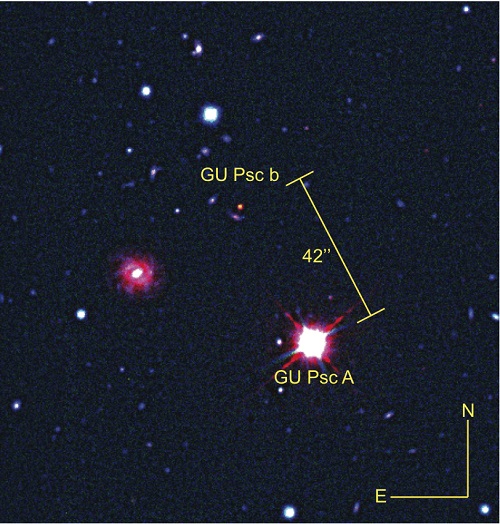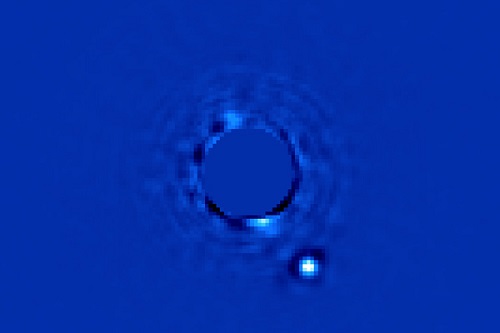How do you go about characterizing a directly imaged planet around another star? In the absence of a transit, one way is to apply theoretical models of planetary formation and evolution to the light spectrum you’re working with. When a team of researchers led by Marie-Ève Naud (a graduate student at the Université de Montréal) used these methods on direct imaging data from four different observatories to characterize a planet 155 light years from the Earth, they arrived at a temperature of some 800 degrees Celsius. The work drew inferences based upon the location of the newly detected world. For the planet, GU Piscium b, orbits a star that is a member of the AB Doradus moving group, some 30 stars that move together with the star AB Doradus.
The AB Doradus association is helpful because a moving group is made up of stars of roughly the same age and metallicity, a sign they probably formed in the same location. The fact that these are young stars, perhaps 100 million years old, also helped the team pull together an estimate of the planet’s mass, some 9 to 13 times that of Jupiter. The striking thing about GU Piscium b is that it orbits at about 2000 AU, the farthest exoplanet from its host that I am aware of. A single trip around its star would take GU Piscium b some 80,000 years. That distance makes infrared detection possible, particularly since young planets like this are still cooling and are therefore brighter.

Image: The planet GU Piscium b and its star GU Piscium. This image is composed of visible and infrared images from the Gemini South telescope and an infrared image from the CFHT. Because infrared light is invisible to the naked eye, astronomers use a color code in which infrared light is represented by the color red. GU Piscium b is brighter in infrared than in other filters, which is why it appears red in this image. Credit: Gemini Observatory/OMM/CFHT/W.M. Keck Observatory.
René Doyon, director of the Observatoire Mont-Mégantic (OMM) some 200 kilometers east of Montreal, calls GU Piscium b “a true gift of nature,” noting that its large distance from the star means a number of instruments can study it in depth, including smaller telescopes like the one at OMM. In this case, the work also involved the Gemini Observatory, the Canada-France-Hawaii Telescope (CFHT) and the W.M. Keck Observatory, whose combined resources produced images at a variety of wavelengths. Having such a clearly defined object for direct imaging studies should be helpful as we work on imaging planets closer to their stars.
On that score, a nod to the debut of the Gemini Planet Imager (GPI), whose first image produced the high-quality result shown below. This is Beta Pictoris b, some 63 light years from Earth, seen through a single 60-second exposure. The GPI’s advanced optics can detect planets down to Jupiter mass orbiting stars similar to the Sun, whereas the previous generation of adaptive optics could image planets no smaller than three times Jupiter’s mass, and only planets as far from their star as Saturn or Neptune is from the Sun.

Image: The bright white dot is the planet Beta Pictoris b, glowing in the infrared light from the heat released when it was formed 10 million years ago. The bright star Beta Pictoris is hidden behind a mask at the center of the image. (Image processing by Christian Marois, NRC Canada).
So we’ve had only a few planets directly imaged, but we’re making progress. Enough so that Bruce Macintosh, principal investigator on the GPI project, predicts in the team’s paper on this work that the planet may transit the host star in 2017, based on information gleaned from the GPI dataset, which yielded clues to the planet’s orbit. A transit of a directly imaged planet would open up in-depth investigation of the planet’s characteristics — remember that Kepler, although it has found thousands of transiting worlds, cannot produce direct imagery of any of them.
And no, not even the Gemini Planet Imager, in operation since November at its site in Chile, will let us see planets as small as the Earth. But Macintosh sees a continued and positive evolution in our capabilities. “…[I]t’s a step on the road,” he added. “Some day a future space telescope will use the same technology, and be able to see an Earth around one of these nearby stars.”
The Beta Pictoris b paper is Macintosh et al., “First light of the Gemini Planet Imager,” published online by Proceedings of the National Academy of Sciences (abstract). The GU Piscium b paper is Naud et al., “Discovery of a Wide Planetary-Mass Companion to the Young M3 Star GU Psc,” The Astrophysical Journal Vol. 787, No. 1 (2014). Abstract and preprint available.



Great to have you back Paul
I have a question for everyone about this:
“The GPI’s advanced optics can detect planets down to Jupiter size orbiting stars similar to the Sun, whereas the previous generation of adaptive optics could image planets no smaller than three times Jupiter’s mass…”
I’m a little surprised by this since the size of a 3M_Jupiter planet is expected to be the same as a 1M_Jupiter planet
Does this difference in brightness all come down to a difference in density?
Lionel, let me check with Bruce Macintosh at GPI to get you a definitive answer.
Lionel, the articles are being rather sloppy about their use of size. The word “mass” should be used instead. You’re absolutely correct that 1 MJ and 3 MJ planets are about the same size, but the mass is what controls their infrared detectability.
Good point, Thomas, and I’m going to make a change in the text to reflect it.
Off-topic, but potentially very relevant research with regard to inner system rocky planets:
Analyzing sun-like stars that eat Earth-like planets
http://www.sciencedaily.com/releases/2014/05/140519215039.htm
@Thomas Tarrants May 20, 2014 at 9:40
‘You’re absolutely correct that 1 MJ and 3 MJ planets are about the same size, but the mass is what controls their infrared detectability.’
This is not exactly right, the same size at the same temperature is the same luminosity, so is not dependant on mass. A heavier mass will have more heat stored though. A 13 J planet billions of years old may have the same temperature as a smaller less massive younger body. There are many factors that affect the detection of these objects other than temperature.
Re Lionel’s question, this just in from Bruce Macintosh — many thanks to Dr. Macintosh for the quick response:
“Good question by your reader – they’re correct that a 1 MJ and a 3 MJ or even 10 MJ planet are all basically the same radius, due to the increased density of bigger planets (which comes from the details of the equation of state of hydrogen.)
“However, in this case, we’re looking not at the light reflected by these planets but by the near-infrared glow from their thermal emission, and the planets are hot because they’re young – when a planet forms, energy is released and so the planet is initially hot and then cools down over the next few hundred million years. More massive planets release more energy, so they’re hotter and hence brighter at any given age. This actually a pretty steep relationship (brightness goes as mass ^ 2.5 or so) for the younger planets.”
Paul and Thomas, thanks for your helpful replies
Another question:
GU Piscium B ‘s temperature is given as 1070 degrees Kelvin – in the top half of the stated temperature range for brown dwarfs (700 to 1300 Kelvin) so shouldn’t the authors be calling it a brown dwarf?
I don’t think it’s clear whether this distant companion is a planet or a brown dwarf. Going by its published mass and temperature it seem to fall near the rather blurry dividing line between overfed Jupiters and starving Brown dwarfs. That’s not to take anything away from the acheivement of its discovery and imaging. Always fun to learn about new found things.
It’s great to see new articles again Paul, I hope you got caught up on everthing you wanted to take care of.
Impressive – so with brightness going as mass ^ 2.5 , being able to now see 1MJ planets after the previous best of 3MJ represents about a 15x improvement!
With such immense separation I am skeptical that the two bodies are gravitationally bound.
@Mike: I tend to agree that GU Psc b is probably not a member of the same class of objects as the planets found closer to their star. Temperature isn’t particularly suspicious as young giant planets should also be quite warm, but the mass ratio to the primary and wide separation are quite problematic. I suppose it could be an ejected giant planet but that would likely require an additional planet of comparable mass close to the star. Two ~10 Jupiter-mass planets would be an extremely massive planetary system compared to the other systems around similar low-mass stars to GU Psc.
It actually seems to be quite tricky to explain the formation of these wide-separation, low-mass companions: core accretion, gravitational instability and star-like collapse all have their problems. That said, I think that they are probably better classed together with the brown dwarfs rather than planets but I wouldn’t consider it entirely outside the realms of possibility if it turns out that there is a third class of objects in the same mass range.
Apparently a “big” exoplanet announcement on Monday, June 2:
http://nasawatch.com/archives/2014/05/big-extrasolar.html
Big Extrasolar Planet Announcement
By Keith Cowing on May 29, 2014 9:28 AM. 13 Comments
Keith’s note: The Harvard Smithsonian Center for Astrophysics is making some sort of big extrasolar planet announcement Thursday. That’s all we know (we have received nothing under embargo).
Keith’s update: This announcement will be made on Monday at the AAS meeting.
Two of the comments so far provide some potentially useful hints as to what the news may be:
Daniel Eig • 14 hours ago
Here’s the planned presentations that day from their team, just to give an idea of possible announcements…
Rates of Large Flares in Old Solar-like Stars in Kepler Clusters
Ofer Cohen (Harvard-Smithsonian Center for Astrophysics)
Kepler 56: Present & Future Configuration & Obliquity
Gongjie Li (Harvard-Smithsonian Center for Astrophysics)
Three Distinct Exoplanet Regimes Inferred from Host Star Metallicities
Lars A. Buchhave (Harvard-Smithsonian Center for Astrophysics)
HARPS-N Contributions to the Mass-Radius Diagram for Rocky Planets
Dimitar Sasselov (Harvard-Smithsonian Center for Astrophysics)
Annie Finkbeiner Daniel Eig • 3 hours ago
Background:
K-56: super-Earth system w/ unusual obliquity to star’s spin, implying unusual formation history (Science, 10/18/13, 331); theory of super-Earths is still a moving target
Host stars’ metallicities correlate with size of planets: high metal = large planets; small planets = range of metals; maybe implying that high-metal planetary disks mean planets form more or less readily.
Mass + radius = density, which implies relative rockiness/gassiness of the planet; so far they have densities on only a fraction of the planets.
This is everything I know. You’re welcome.